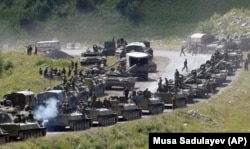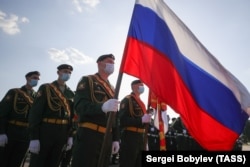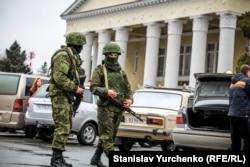As speculation builds about alleged Russian plans for a military attack on NATO-friendly Ukraine, information appears to be emerging as a defensive weapon of choice.
Unlike before Russia’s 2008 attack on Georgia, its 2014 annexation of Crimea or armed support for Moscow-backed separatists in eastern Ukraine, online news outlets are awash in information from Western and Ukrainian officials about alleged attack strategies, Russian troop deployment, and materiel accumulating on Ukraine’s eastern border and on the Russian-occupied Crimean peninsula.
Until a few weeks ago, however, some Ukrainian officials and interviewed analysts heartily denied any such Russian military buildup, terming related U.S. media reports “disinformation” that only serves Moscow.
But amidst warnings from NATO, the U.S. defense and intelligence community, and reports by prestigious U.S. media outlets, that stance has changed. Discussing Russia’s supposed attack plans -- Moscow categorically denies any intentions of an invasion -- appears seen as a way of ensuring they do not become a reality.
As tensions increase with Ukraine, the “information component” ranks as “very important” and “essential” for the Russian government, commented retired Lieutenant General Ihor Romanenko, who acted as deputy chief of staff for Ukraine’s armed forces between 2006 and 2010.
Romanenko, a Soviet-trained officer who specializes in air defense, contends that, as with Russia’s 2008 war with Georgia, Moscow intends to position its troops first and come up with a reason for their deployment later.
In Georgia in 2008, Moscow justified its invasion of the country’s separatist South Ossetia region by the supposed need to protect Russian passport holders and peacekeepers from “genocide” as Tbilisi moved to regain control of South Ossetia. (International investigators found no grounds for such charges, though said that Tbilisi had overreacted to separatist attacks.)
In 2021, Moscow is recirculating, without documented proof, old claims that Kyiv plans to attack the Moscow-backed, separatist-controlled areas of eastern Ukraine’s Donetsk and Luhansk regions. Such theories have persisted since fighting first began with Russian-backed separatists in 2014-2015.
Russia's Foreign Intelligence Service likened the situation to tensions with Georgia in 2008 ahead of the five-day August war that, spokesman Sergei Ivanov warned, cost then Georgian leader Mikheil Saakashvili "dearly."
But a researcher from the Conflict Intelligence Team (CIT), which uses open-source intelligence to track military activity in eastern Ukraine’s Donbas conflict, rejected claims of a pending Ukrainian attack as justification for the pileup in Russian forces near Ukraine’s border.
Forces from Russia's 1st Guards Tank Army, a noted combat formation that dates from World War II, have joined the 4th Guards Tank Division along the Ukrainian border, according to CIT researcher Kirill Mikhailov. Meanwhile, units from the 49th and 58th Combined-Arms Armies of Russia’s Southern Military District have been observed in Crimea, he added.
“Despite the fact that Russian propaganda again starts to talk about some Ukrainian attack there on the territory of Donbas,” Mikhailov said, “it’s clear that tank units are needed not for the defense of Donetsk and Luhansk, but to attack territory under the control of the Ukrainian authorities if there is a political decision” to do so.
The number of Russian troops stationed near the Ukrainian border is “already comparable, if not the same” as in April 2021, when fears of a Ukrainian-Russian war last emerged, Mikhailov continued. Ukrainian officials then estimated as many as 100,000 - 120,000 Russian troops, although critics deemed that tally exaggerated.
If the buildup continues at its current pace, there could be “many more forces” in the border area by late January or early February, Mikhailov said.
In a November 21 interview with Military Times, an outlet for the U.S. armed services, Brigadier General Kyrylo Budanov, the head of the Ukrainian Defense Ministry’s intelligence directorate, stated that Moscow plans to launch an attack during that timeframe. He estimated current Russian troop strength at over 92,000.
But unlike Russia’s surprise 2014 deployment of “little green men” – armed Russian soldiers in unmarked uniforms -- to take over Crimea, any Russian attack on Ukraine now cannot be a “blitzkrieg,” stressed Mykhailo Gonchar, president of the Strategy XXI Centre for Global Studies, a Kyiv think tank.
Western media’s publication of satellite footage that reveals the locations of Russian military equipment near Ukraine prevents such a scenario, Gonchar believes.
In response, Moscow is presenting itself as under attack. Russian President Vladimir Putin has asked for a security guarantee from the West, while Kremlin spokesman Dmitry Peskov, watching Russia’s alleged troop strength and equipment deployment make headlines worldwide, insists that the West is attempting a “provocation.”
In a November 23 briefing, Peskov again stressed that “Russia doesn’t intend to attack anyone” and deemed it “completely incorrect” to “associate with such plans any movements of the Russian Federation’s armed forces on the territory of our country," TASS reported.
Nonetheless, in international media, Ukrainian military experts and anonymous “U.S. officials” are getting down to Russia’s supposed battle plans.
Like his Western counterparts, Romanenko believes that the main strikes could come from Ukraine’s eastern border with Russia and the south, where Crimea is located, but that the attack could be multi-pronged, with the involvement of Belarusian troops from the north and additional Russian troops from Moldova’s pro-Moscow separatist region of Transdniester, which borders Ukraine’s south.
“With this in mind, it won’t be difficult [for Russia] to act simultaneously from all of these sides when it’s necessary to fight back from all sides except from the back -- that is, from the West.”
The "minimum" aim, he believes, is to secure a land corridor from Russia to Crimea and expand separatist-controlled territory in Donbas.
But rather than a broad-scale push into Ukraine from the east, stretching from the northern city of Chernihiv to the southern port city of Mariupol, Gonchar reasons that Moscow could opt first for “targeted strikes” and “use the factor of struggle against Ukraine from within Ukraine.”
“I think that, first of all, there may be the idea of showing that Russia can do this just like, in their own time, the United States and NATO crushed Yugoslavia” in 1999, said Gonchar, who formerly worked for Ukraine’s National Security and Defense Council.
Primary among Moscow's goals, he believes, is securing Western agreement that Ukraine, as part of Russia's sphere of influence, will not be part of NATO and that Crimea is part of Russia.
Moscow wagers that it could take such steps, he continued, based on its calculation “that, amidst a military escalation, the West will do everything so that there won’t be a massive war because, in any case, Ukraine is not a NATO member.”
Releasing information about increased U.S. military aid to Ukraine (CNN) and NATO allies’ determination that the Russian buildup is not “a bluff” (The New York Times) appears to be part of any such deflection strategy.
Two unnamed “people familiar with the conversations” told Bloomberg that Russia already has positioned about half of roughly 100 battalion tactical groups, numbering around 100,000 troops, that it plans to send, with air support, into Ukrainian-controlled territory from the two countries’ border, Russian-occupied Crimea, and via Belarus.
The U.S. reportedly also has shared with its allies details about an “exponential rise” in disinformation within Ukraine, long a Russian target.
But if these releases of information will forestall any military action by Moscow, the Kremlin’s Peskov is not letting on.
“Who is attacking whom?” he asked journalists at a November 23 briefing. “Russia [is attacking] Ukraine or Ukraine [is attacking] Russia?”
For now, the answer could depend on where you get your news.















